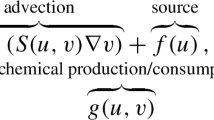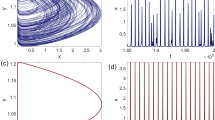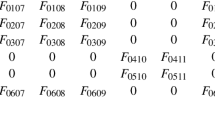Abstract
In this paper we develop a theoretical framework for investigating pattern formation in biological systems for which the tissue on which the spatial pattern resides is growing at a rate which is itself regulated by the diffusible chemicals that establish the spatial pattern. We present numerical simulations for two cases of interest, namely exponential domain growth and chemically controlled growth. Our analysis reveals that for domains undergoing rapid exponential growth dilution effects associated with domain growth influence both the spatial patterns that emerge and the concentration of chemicals present in the domain. In the latter case, there is complex interplay between the effects of the chemicals on the domain size and the influence of the domain size on the formation of patterns. The nature of these interactions is revealed by a weakly nonlinear analysis of the full system. This yields a pair of nonlinear equations for the amplitude of the spatial pattern and the domain size. The domain is found to grow (or shrink) at a rate that depends quadratically on the pattern amplitude, the particular functional forms used to model the local tissue growth rate and the kinetics of the two diffusible species dictating the resulting behaviour.
Similar content being viewed by others
References
Alberts, B., Bray, D., Lewis, J., Raff, M., Roberts, K., Watson, J.D., 1994. Molecular Biology of the Cell. Garland Publishing, New York.
Alison, M.R., Sarraf, C.E., 1997. Understanding Cancer. Cambridge University Press, Cambridge, New York and Melbourne.
Benson, D.L., Maini, P.K., Sherratt, J.A., 1998. Unravelling the Turing bifurcation using spatially varying diffusion coefficients. J. Math. Biol. 37, 381–417.
Benson, D.L., Sherratt, J.A., Maini, P.K., 1993. Diffusion driven instability in an inhomogeneous domain. Bull. Math. Biol. 55, 365–384.
Breward, C.J.W., Byrne, H.M., Lewis, C.E., 2002. The role of cell—cell interactions in a two-phase model for avascular tumour growth. J. Math. Biol. 45, 125–152.
Byrne, H.M., Chaplain, M.A.J., 1995. Growth of nonnecrotic tumors in the presence and absence of inhibitors. Math. Biosci. 130, 151–181.
Byrne, H.M., Chaplain, M.A.J., 1997. Free boundary value problems associated with the growth and development of multicellular spheroids. Eur. J. Appl. Math. 8, 639–658.
Byrne, H.M., Chaplain, M.A.J., 1998. Necrosis and apoptosis: Distinct cell loss mechanisms in a mathematical model of avascular tumour growth. J. Theor. Med. 1, 223–235.
Byrne, H.M., Matthews, P.C., 2002. Asymmetric growth of models of avascular solid tumours: exploiting symmetries. IMA J. Math. Appl. Med. Biol. 19, 1–29.
Campbell, J.W., Pollack, I.F., 1997. Growth factors in gliomas: Antisense and dominant negative mutant strategies. J. Neuro-Oncol. 35, 275–285.
Casciari, J.J., Sotirchos, S.V., Sutherland, R.M., 1992. Mathematical modelling of microenvironment and growth in EMT6/Ro multicellular tumour spheroids. Cell Prolif. 25, 1–22.
Chaplain, M.A.J., 1996. Avascular growth, angiogenesis and vascular growth in solid tumours: The mathematical modelling of the stages of tumour development. Math. Comp. Mod. 23, 47–87.
Chaplain, M.A.J., Ganesh, M., Graham, I.G., 2001. Spatio-temporal pattern formation on spherical surfaces: Numerical simulation and application to solid tumour growth. J. Math. Biol. 42, 387–423.
Crampin, E.J., Gaffney, E.A., Maini, P.K., 1999. Reaction and diffusion on growing domains: Scenarios for robust pattern formation. Bull. Math. Biol. 61, 1093–1120.
Crampin, E.J., Hackborn, W.W., Maini, P.K., 2002. Pattern formation in reaction-diffusion models with nonuniform domain growth. Bull. Math. Biol. 64, 747–769.
Crank, J., 1984. Free and Moving Boundary Problems. Clarendon Press (Oxford University Press), Oxford.
Fiedler, B., Liebscher, S., Alexander, J.C., 2000. Generic Hopf bifurcation from lines of equilibria without parameters: I. Theory. J. Diff. Equat. 167, 16–35.
Fodde, R., 2001. Apc, signal transduction and genetic instability in colorectal cancer. Nat. Rev. Cancer 1, 55–67.
Franks, S.J., King, J.R., 2003. Interactions between a uniformly proliferating tumour and its surroundings: uniform material properties. Math. Med. Biol. 20, 47–89.
Gierer, A., Meinhardt, H., 1972. A theory of biological pattern formation. Kybernetik 12, 30–39.
Gray, P., Scott, S.K., 1983. Autocatalytic reactions in the isothermal, continuous stirred tank reactor. Chem. Eng. Sci. 38, 29–43.
Greenspan, H.P., 1976. On the growth and stability of cell cultures and solid tumours. J. Theor. Biol. 56, 229–242.
Grindrod, P., 1996. The Theory and Applications of Reaction-Diffusion Equations—Patterns and Waves of Oxford Applied Mathematics and Computing Science Series. Clarendon Press (Oxford University Press), Oxford.
Harrison, L.G., Kolá, M., 1988. Coupling between reaction-diffusion prepattern and expressed morphogenesis, applied to desmids and dasyclads. J. Theor. Biol. 130, 493–515.
Jackson, T.L., 2002. Vascular tumor growth and treatment: Consequences of polyclonality, competition and dynamic vascular support. J. Math. Biol. 44, 201–226.
Jones, A.F., Byrne, H.M., Gibson, J.S., Dold, J.W., 2000. A mathematical model of the stress induced during avascular tumour growth. J. Math. Biol. 40, 473–499.
Kondo, S., Asai, R., 1995. A reaction-diffusion wave on the skin of the marine angelfish Pomacanthus. Nature 376, 765–768.
Kuhnert, F., Davis, C.R., Wang, H.T., Chu, P., Lee, M., Yuan, J., Nusse, R., Kuo, C.J., 2004. Essential requirements for Wnt signalling in proliferation of adult small intestine and colon revealed by adenoviral expression of Dickkopf-1. Proc. Natl. Acad. Sci. USA 101, 266–271.
Lengyel, I., Epstein, I.R., 1991. Modelling of Turing structures in the chlorite iodide malonic acid starch reaction system. Science 251, 650–652.
Maini, P.K., Painter, K.J., Nguyen Phong Chau, H., 1997. Spatial pattern formation in chemical and biological systems. J. Chem. Soc. Faraday Trans. 93, 3601–3610.
Majack, R.A., 1987. Beta-type transforming growth factor specifies organizational behaviour in vascular smooth muscle cell cultures. J. Cell Biol. 105, 465–471.
Matthews, P.C., 1998. Hexagonal patterns in finite domains. Physica D 116, 81–94.
Murray, A., Hunt, T., 1993. The Cell Cycle. Oxford University Press, Oxford, New York, Toronto and Delhi.
Murray, J.D., 1981. A pre-pattern formation mechanism for animal coat markings. J. Theor. Biol. 88, 161–199.
Murray, J.D., 1993. Mathematical Biology, of Biomathematics Texts, vol. 19, 2nd edition. Springer-Verlag, Berlin and London.
Neubert, M.G., Caswell, H., Murray, J.D., 2002. Transient dynamics and pattern formation: reactivity is necessary for Turing instabilities. Math. Biosci. 175, 1–11.
Neville, A.A., 2003. Biomedical Modelling Incorporating Growth, PhD thesis, University of Nottingham, Nottingham, England.
Ouyang, Q., Swinney, H.L., 1991. Transition from a uniform state to hexagonal and striped Turing patterns. Nat. (Lond.) 352, 610–612.
Owen, M.R., Sherratt, J.A., 1999. Mathematical modelling of macrophage dynamics in tumours. Math. Mod. Meth. Appl. Sci. 9, 513–539.
Painter, K.J., Maini, P.K., Othmer, H.G., 1999. Stripe formation in juvenile Pomacanthus explained by a generalised Turing mechanism with chemotaxis. Proc. Natl. Acad. Sci. USA 96, 5549–5554.
Painter, K.J., Maini, P.K., Othmer, H.G., 2000. Development and applications of a model for cellular response to multiple chemotactic cues. J. Math. Biol. 41, 285–314.
Pettet, G.J., Please, C.P., Tindall, M.J., McElwain, D.L.S., 2001. The migration of cells in multicell tumor spheroids. Bull. Math. Biol. 63, 231–257.
Pinto, D., Gregorioff, A., Beghtel, H., Clevers, H., 2003. Canonical Wnt signals are essential for homeostasis of the intestinal epithelium. Genes Dev. 17, 1709–1713.
Santini, M.T., Rainaldi, G., Indovina, P.L., 2000. Apoptosis, cell adhesion and the extracellular matrix in the three-dimensional growth of multicellular tumor spheroids. Crit. Rev. Oncol. Hemat. 36, 75–87.
Schnakenberg, J., 1979. Simple chemical reaction systems with limit cycle behaviour. J. Theor. Biol. 81, 389–400.
Sherratt, J.A., Chaplain, M.A.J., 2001. A new mathematical model for avascular tumour growth. J. Math. Biol. 43, 291–312.
Turing, A.M., 1952. The chemical basis of morphogenesis. Phil. Trans. Roy. Soc. Lond. B237, 37–72.
Varea, C., Aragon, J.L., Barrio, R.A., 1997. Confined Turing patterns in growing systems. Phys. Rev. E 56, 1250–1253.
Ward, J.P., King, J.R., 1997. Mathematical modelling of avascular-tumour growth. IMA J. Math. Appl. Med. Biol. 14, 39–69.
Ward, J.P., King, J.R., 1999. Mathematical modelling of avascular-tumour growth II: Modelling growth saturation. IMA J. Math. Appl. Med. Biol. 16, 171–211.
Wein, L.M., Wu, J.T., Kirn, D.H., 2003. Validation and analysis of a mathematical model of a replication and competent oncolytic virus for cancer treatment: implications for virus design and delivery. Cancer Res. 63, 1317–1324.
Author information
Authors and Affiliations
Corresponding author
Rights and permissions
About this article
Cite this article
Neville, A.A., Matthews, P.C. & Byrne, H.M. Interactions Between Pattern Formation and Domain Growth. Bull. Math. Biol. 68, 1975–2003 (2006). https://doi.org/10.1007/s11538-006-9060-5
Received:
Accepted:
Published:
Issue Date:
DOI: https://doi.org/10.1007/s11538-006-9060-5




